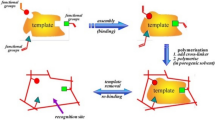Abstract
Molecularly imprinted polymers (MIPs) for quercetin have been successfully prepared by a thermal polymerization method using 4-vinylpyridine (4-VP) and ethylene glycol dimethacrylate (EDMA) as functional monomer and cross-linker, respectively. The obtained molecularly imprinted polymers were evaluated by HPLC using organic eluents, with respect to their selective recognition properties for quercetin and related compounds of the flavonoid class. Two equivalent control polymers, a blank polymer and a polymer imprinted with a structural analogous template, were synthesized, in order to confirm the obtained results. Furthermore, preliminary experiments confirm the applicability of the prepared MIPs for solid phase extraction (SPE), as rapid and facile clean-up of wine samples for HPLC analysis is an envisaged field of application. The successful preparation of molecularly imprinted polymers for flavones provides an innovative opportunity for the development of advanced separation materials, with applications in the field of wine and fermentation analysis.
Similar content being viewed by others
References
Andersson LI (2000a) Molecular imprinting for drug bioanalysis: A review on the application of imprinted polymers to solid-phase extraction and binding assay. J. Chromatogr. B 739: 163-173
Andersson LI (2000b) Efficient sample pre-concentration of bupivacaine from human plasma by solid-phase extraction on molecularly imprinted polymers. Analyst 125: 1515-1517
Da Silva JMR, Rosec JP, Bourzeix M & Heredia N (1990) Separation and quantitative determination of grape and wine procyanid387 ins by high-performance reversed phase liquid chromatography. J.Sci. Food. Agric. 53: 85-92
Goldberg DM, Tsang E, Karumanchiri A, Diamandis EP, Soleas G & Ng E (1996) Method to assay the concentrations of phenolic constituents of biological interest in wines. Anal. Chem. 68(10): 1688-1694
Harnborne J.B. (1994) The Flavonoids: Aadvances in Research Since 1986. Chapman and Hall, London.
Haupt K, Dzgoev A & Mosbach K (1998) Assay system for herbicide 2,4-dichlorophenoxyacetic acid using a molecularly imprinted polymer as an artificial recognition element. Anal. Chem. 70: 628-631
Janotta M, Weiss R, Mizaikoff B, Brüggemann O, Ye L & Mosbach K (2001) Molecularly Imprinted polymers for nitrophenols-an advanced separation material for environmental analysis. Internat. J. Environ. Anal. Chem. 80: 75-86
Kempe M, Fischer L & Mosbach K (1993) Chiral separation using molecularly imprinted heteroaromatic polymers. J. Mol. Recogn. 6: 25-29
Lamuela-Raventós RM & Waterhouse AL (1994) A direct HPLC separation of wine phenolics. Am. J. Enol. Vitic. 45(1): 1-5
Laworski A & Lee CY (1987) Fractionation and HPLC determination of grape phenolics. J. Agric. Food. Chem. 35: 257-259
Meylan WM & Howard PH (1995) Atom/fragment contribution method for estimating octanol-water partition coefficients. J. Pharm. Sci. 84: 83-92
Nomura Y, Muguruma H, Yano K, Kugimiya A, McNiven S, Ikebukuro K & Karube I (1998) Selective recognition of 2,4-dichlorophenoxyacetic acid using a molecularly imprinted polymer. Anal. Lett. 31(6): 973-980
Oszmianski J, Ramos T & Bourzeix M (1988) Fractionation of phenolic compounds in red wine. Am. J. Enol. Vitic. 39(3): 259-262
Revilla E & Ryan JM (2000) Analysis of several phenolic compounds with potential antioxidant properties in grape extracts and wines by high-performance liquid chromatography-photodiode array detection without sample preparation. J. Chromatogr. A 881: 461-469
Ribéreau-Gayon P, Glories Y, Maujean A & Dubourdieu (2000) Handbook of Enology, Vol. 2: The Chemistry of Wine Stabilization and Treatments. John Wiley & Sons Ltd, New York
Roggero JP, Archier P & Coen S (1997) Wine. nutritional and therapeutic benefits. In:Watkins TR (ed.) ACS Symposium Series, No 661 (p.6) American Chemical Society, Washington, DC
Russo N, Toscano M & Uccella N (2000) Semiempirical molecular modeling into quercetin reactive site: structural, conformational, and electronic features. J. Agric. Food Chem. 48: 3232-3237
Salagoïty-Auguste MH & Bertrand A (1984) Wine phenolics-analysis of low molecular weight components by high performance liquid chromatography. J. Sci. Food. Agric. 35: 1241-1247
Soleas GJ, Diamandis EP, Karumanchiri A & Goldberg DM (1997) A Multiresidue derivatization gas chromatographic assay for fifteen phenolic constituents with mass selective detection. Anal. Chem. 69: 4405-4409
Stevenson D (1999) Molecular imprinted polymers for solid phase extraction. TRAC 18(3): 154-158
Wulff G & Minarik M (1990) Template imprinted polymers for HPLC separation of racemates. J. Liq. Chromatogr. 13(15): 2987-3000
Author information
Authors and Affiliations
Corresponding author
Rights and permissions
About this article
Cite this article
Weiss, R., Molinelli, A., Jakusch, M. et al. Molecular imprinting and solid phase extraction of flavonoid compounds. Bioseparation 10, 379–387 (2001). https://doi.org/10.1023/A:1021554106297
Issue Date:
DOI: https://doi.org/10.1023/A:1021554106297




